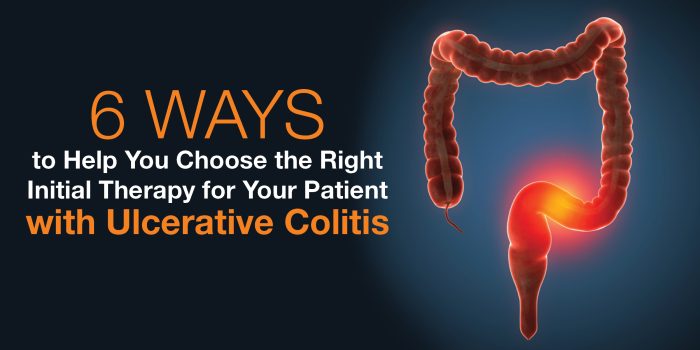
Choosing the correct first therapy for your patients with ulcerative colitis (UC) can be tricky, but it is important because it gives them the best chance at a better life with UC. Getting it right early increases their odds of remission and reduces their risk of progression, hospitalization, and colectomy.[1] Here are 6 ways to help get it right the first time.
The American Gastroenterological Association (AGA) ulcerative colitis guidelines recommend starting a biologic early. The management of UC has largely moved away from the step-up approach that used to require less intensive treatment options to be used before biologics to now utilizing biologics (and small molecule targeted therapies) earlier in the disease process.[2]
However, guidelines are only updated periodically, so newly approved treatment options, like ustekinumab and upadacitinib, will not be represented in the guidelines until the next update. The guidelines also do not personalize treatment. For instance, vedolizumab and infliximab are both recommended in the first line; although this provides a framework for the clinician to work within, it does not personalize that treatment consideration is based on biomarkers, disease severity, or prognosis.
The VARSITY trial is a head-to-head trial in UC comparing vedolizumab versus adalimumab.[3] However, head-to-head trials, though valuable, are limited. This is where network meta-analyses become helpful. These types of studies use available clinical trial data to compare the superiority of different drugs to each other, with placebo as the comparator, based on a certain outcome, such as clinical remission or endoscopic improvement. These are valuable because they can help clinicians position therapies where direct head-to-head studies are lacking or where recommendations have not yet been made.[4] However, while they help with positioning treatments relative to each other, the positioning is not at the individual patient level and the patient population is usually not representative of the routine patient population seen in the clinic.
Subjects in clinical trials are often dissimilar to real-world patients, which limits generalizability. This is where real-world comparative effectiveness studies are helpful. One such study compared vedolizumab against anti-TNF therapy in over 600 patients with UC across 15 centers in the United States.[5] When taken together, a study such as this can help contextualize clinical trial datasets into routine practice and also help compare real-world safety data. However, while real-world data definitely provides context, it is still population level data.
To solve this problem, a globally accessible and freely available predictive CDST was built to help translate clinical trial data, which are aggregate population comparisons, to individual patients. Phase 3 clinical trial data for vedolizumab in UC was coupled with patient-level data and used to build a predictive model that was then validated in a consortium dataset. The CDST has a user-friendly interface and, through a series of binary questions about the patient’s history, clinical, endoscopic, and laboratory findings, it assesses an individual’s risk of colectomy. If the risk is high, the provider can then proceed to the predictive model. Here they can input additional information about the patient’s history and labs and the tool will calculate the patient’s probability of achieving remission on vedolizumab compared to an anti-TNF therapy, how quickly they can expect a response, and if additional monitoring will be required.
Click here to learn more about choosing the right UC treatment first.
As always, it is important to discuss prognosis, treatment options, and risk tolerance with your patient and understand their goals and priorities when it comes to treatment and lifestyle. If a patient cannot integrate a certain therapy into their lifestyle, it will not work for them. If a patient is not convinced of a treatment strategy, they may not adhere to it. The IBD CDST can help facilitate this conversation by demonstrating to patients their personal colectomy risk and their personal probability of responding to therapy.
Click here to learn more about shared decision making in UC.
Patients with UC can benefit from a multidisciplinary and interprofessional team approach to healthcare. An IBD nurse can help coordinate assessment, education, integrate treatment into a patient’s lifestyle, and build trust.[6] Pharmacists can help with medication therapy management, recognizing side effects, injection training, navigating insurance, and enrolling in co-pay assistance programs.[7] The integration of an interprofessional team in the management of UC has also shown to improve disease control, reduce hospitalizations, and lower costs.[6][7]
[1] Fumery M, et al. Clin Gastroenterol Hepatol. 2018;16(3):343-356.
[2] Feuerstein JD, et al. Gastroenterology. 2020;158(5):1450-1461.
[3] Sands BE, et al. N Engl J Med. 2019;381(13):1215-1226.
[4] Lasa JS, et al. Lancet Gastroenterol Hepatol. 2022;7(2):161-170.
[5] Lukin D, et al. Clin Gastroenterol Hepatol. 2022;20(1):126-135.
[6] Rosso C, et al. Nurs Rep. 2021;11(2):229-241.
[7] Prasad SS, et al. Pharmacy (Basel). 2020;8(4):204.
Share on Social Media
Earn CE Credit(s) with RMEI Medical Education